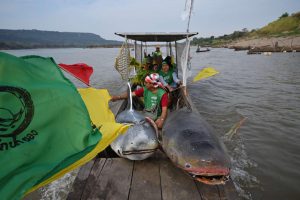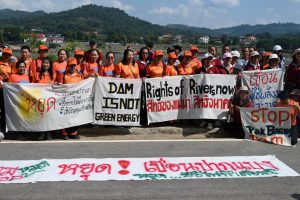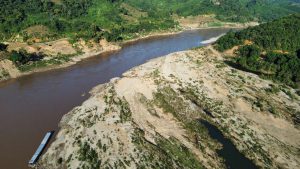[Press Release / Joint Statement]
On July 23, 2018, the auxiliary dam (Saddle D) of the Xe-Pian Xe-Namnoy hydroelectric power project in Laos collapsed, killing 71 people, displacing thousands, and flooding homes and villages. Five years after this tragic incident, the survivors have still not received adequate compensation or remedy and continue to suffer from the impacts of the disaster. NGOs* are calling on the corporations and governments involved—including the project developer SK Ecoplant, its operator the Xe-Pian Xe-Namnoy Power Company (PNPC), as well as the Lao government and the Republic of Korea, which provided ODA funding—to acknowledge their wrongdoing and fulfill their duty to ensure reparations.
SK Ecoplant is still denying its responsibility for the disaster
SK Ecoplant, the constructor of the Xe-Pian Xe-Namnoy hydroelectric power project, has filed an international arbitration in Singapore against PNPC, the company in charge of operating the dam, arguing that the collapse was not caused by faulty construction but by a natural disaster (force majeure), so it is unfair for the contractor to be held accountable for the costs, including compensation.
However, experts agree that the disaster was man-made. On May 28, 2019, the Independent Expert Panel (IEP) of the National Investigation Committee established by the Lao government released the results of its investigation, stating that the Xe-Pian Xe-Namnoy Dam collapse could have been prevented by proper measures to secure the foundation.
In 2022, SK Ecoplant publicly announced a ‘Human Rights Policy Statement’ asserting that it actively acts to fulfill its corporate social responsibilities and is a human rights-friendly company. Before promoting itself as a socially responsible corporation, SK Ecoplant should acknowledge its responsibility for the tragedy and provide effective remedy.
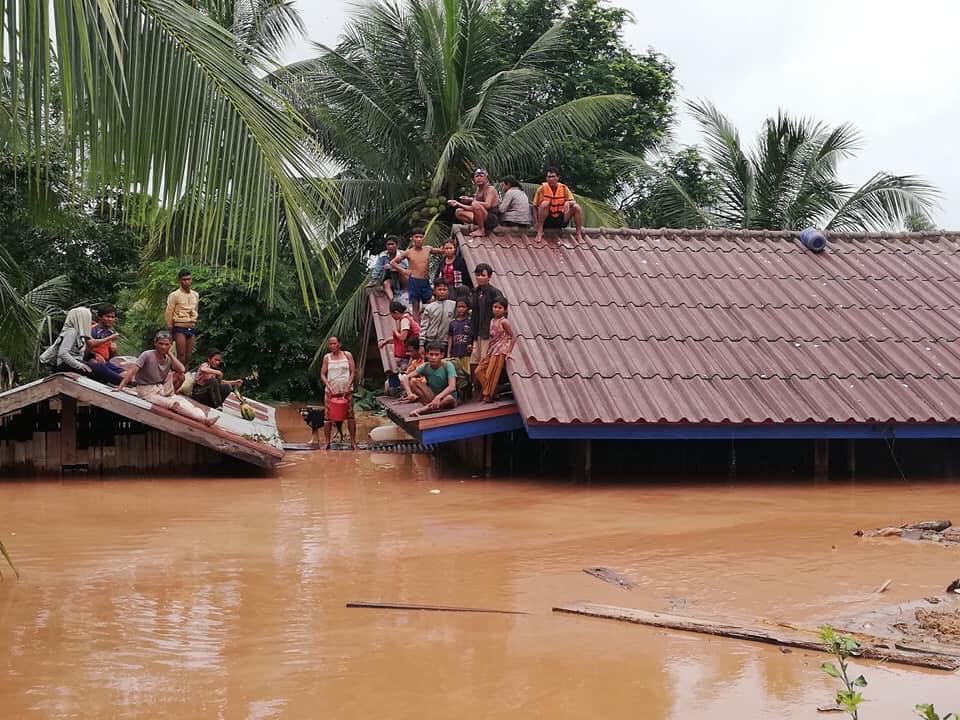
The majority of compensation money was paid to the Lao government, not the affected Communities
PNPC, the official operator of the Xe-Pian Xe-Namnoy Dam in Laos, stated in a letter submitted to UN human rights experts on August 30, 2022, that it had provided a total of $91.2 million for compensation. However, NGOs stress that according to PNPC’s internal records, the majority of the compensation ($64.87 million, or about 71% of the total) was paid to the Lao government, not to the affected people. (See annex.)
This is because all the compensation for housing, land, infrastructure, etc. lost and damaged in the disaster was paid to the Lao government. The Lao government designed a “Master Plan” to clear the rainforest and to build new cities and had PNPC pay for the development. It appears that the compensation process prioritized the development needs of the Lao government over the effective remedy of the survivors. Meanwhile, there is no public information on how the Lao government spent the money it received from PNPC nor the specifics of the “Master Plan”.
According to PNPC, it has paid some monetary compensation to affected villagers for loss of life and property damage. However, as of June this year, PNPC stated in an email to KTNC Watch, a network of trade unions and civil society organizations based in South Korea, that compensation for valuables and other items of emotional value, which were washed away by the flood but not included in the property damage evaluation, is yet to be complete. We also confirm that there has been no compensation for the psychological damage caused by the tragedy, nor any support for trauma recovery.
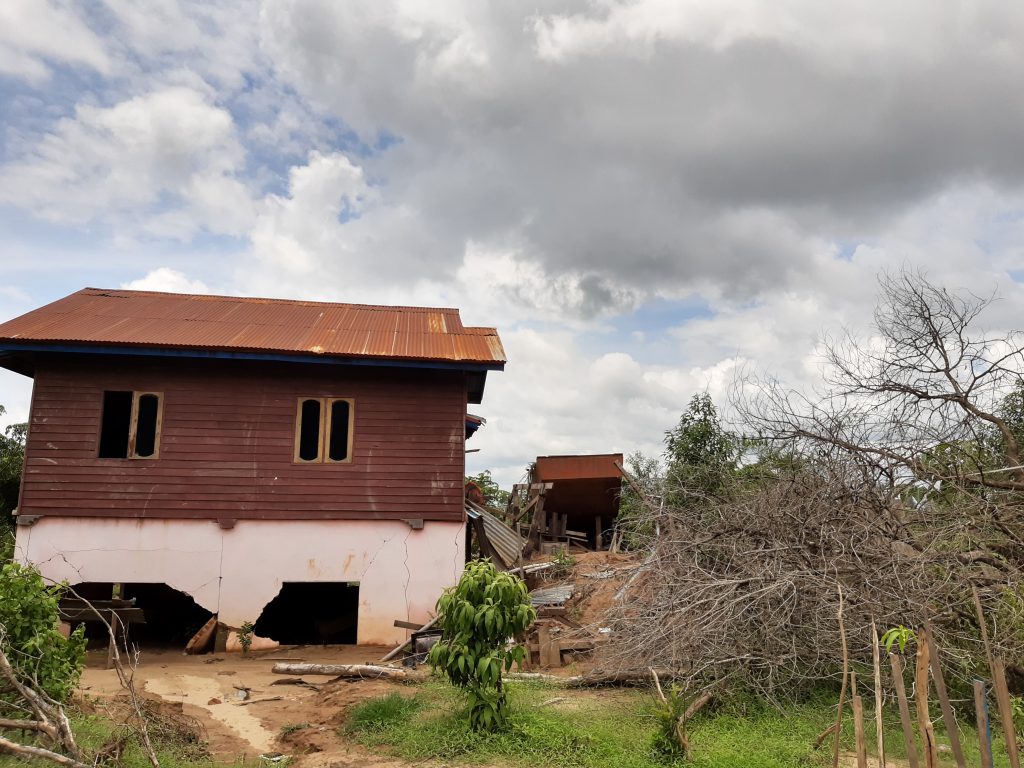
Survivors are uprooted from their longtime homeland, and left without sustainable livelihood
According to KTNC Watch’s interviews with the survivors, the survivors were relocated to unfamiliar lands and are not provided with sustainable livelihoods.
People in the affected villages have traditionally made a living from rice farming along the Xe Pian River, but PNPC built residential complexes far from their original homes, in accordance with the Lao government’s “Master Plan”. Most of the affected villagers were displaced to the newly built complexes without choice.
As the displaced survivors have lost their traditional livelihood, the Lao government has given them plots of cleared forest. But it turned out that the land is not suitable for rice cultivation. The villagers are now unable to grow their own rice and are instead forced to grow and sell commodity crops such as cassava or lease the land to plantation corporations. However, many of the affected people had been living self-sufficient lives; some of them did not even have personal savings accounts prior to the disaster. Consequently, it is nearly impossible for the affected villagers to suddenly become commercial farmers. In short, not only have the survivors of the dam’s collapse been forced to relocate, but they are not provided with sustainable livelihoods. It is doubtful if the survivors were properly consulted in the relocation process.
We call for full reparation to the affected communities that prioritizes the voice of the survivors
Business entities that caused or contributed to the disaster appear to consider that they fulfilled their responsibilities because they paid a lot of money under the name of ‘compensation’. However, the actual use of the money shows that the companies’ need to avoid liability was matched by the Lao government’s need to clear lands and develop new cities. The true rehabilitation of the survivors was deprioritized, and as a result, the survivors are still suffering from the impact of the disaster, with no guarantee of a sustainable livelihood.
In addition to SK Ecoplant, PNPC, the Lao government, and the Republic of Korea, which provided ODA funding for the Xe-Pian Xe-Namnoy hydropower project, all have a duty to ensure effective remedy and rehabilitation of the survivors of the dam collapse. We urge those agents to provide relief measures prioritizing the needs of the survivors and ensure effective remedy and full rehabilitation to the affected communities, in meaningful consultation with the survivors. <End>
* KTNC Watch (https://ktncwatch.org/)
Manushya Foundation (https://www.manushyafoundation.org/)
Inclusive Development International (https://www.inclusivedevelopment.net/)
International Rivers (https://www.internationalrivers.org/)
Community Resource Centre (CRC), Thailand (https://crcthai.org/)
ETOs Watch Coalition (https://etowatch.com/)
Fair Finance Thailand (https://fairfinancethailand.org/)
Mekong Watch (http://www.mekongwatch.org/)
*** For more information and media requests please contact:
- Yujung Shin (+82 010 8452 0108, yjshin@jihyanglaw.com),
Pillkyu Hwang (hopenvision@naver.com),
or Youngah Park (mashil049@gmail.com). - Emilie Pradichit (emilie@manushyafoundation.org)
Annex. Status of Compensation paid by PNPC
*Source: Korean Western Power(KOWEPO)
| Category | The amount paid (1 mil USD) | Payment rate (%) | Subject of the payment | Payment completion date | |
| Third-party compensation (or Direct compensation) | 1. damage of human life[1] | 1.003078 | 100 | The victim | June 2019 |
| 2-1. damage of housing | 11.500000 | 100 | Lao Govt. | January 2021 | |
| 2-2. other domestic damages[2] | 14.648915 | 100 | The victim | November 2021 | |
| 3. Business[3] | 10.727924 | 100 | The victim | January 2020 | |
| 4. infrastructure | 8.127274 | 100 | Lao Govt. | October 2020 | |
| 5. Environment | 9.401966 | 100 | Lao Govt. | December 2020 | |
| Total | 55.409157 | 100 | |||
| Masterplan (or Indirect compensation) | 1-1. Permanent Housing | 13.000000 | 100 | Lao Govt. & The victims | Paid upon Lao Govt.’s request; paid in 5 installments from April 2021 to July 2022. |
| 1-2. Road, bridges, waterworks, etc. | 6.063402 | 100 | Lao Govt. | ||
| 2.Civil engineering work, etc. | 5.293489 | 100 | Lao Govt. | ||
| 3. Warehouse, etc. | 7.650261 | 100 | Lao Govt. | ||
| 4. school | 0.361532 | 100 | Lao Govt. | ||
| 5. Electricity | 3.224556 | 100 | Lao Govt. | ||
| 6. Medical facilities | 0.257172 | 100 | Lao Govt. | ||
| Total | 35.850412 | 100 | |||
[1] PNPC has paid compensation of $10,000 per person for the 71 deceased, and paid 28 orphaned children compensation money calculated at 1,100,000 KIP (about $57) for each month remaining until each child reaches the age of 18.
[2] Refers to the affected household’s property damage, except for the damages to housing (vehicles, outbuildings, valuables, etc.).
[3] Refers to compensation for business enterprises that operated within the affected area.

